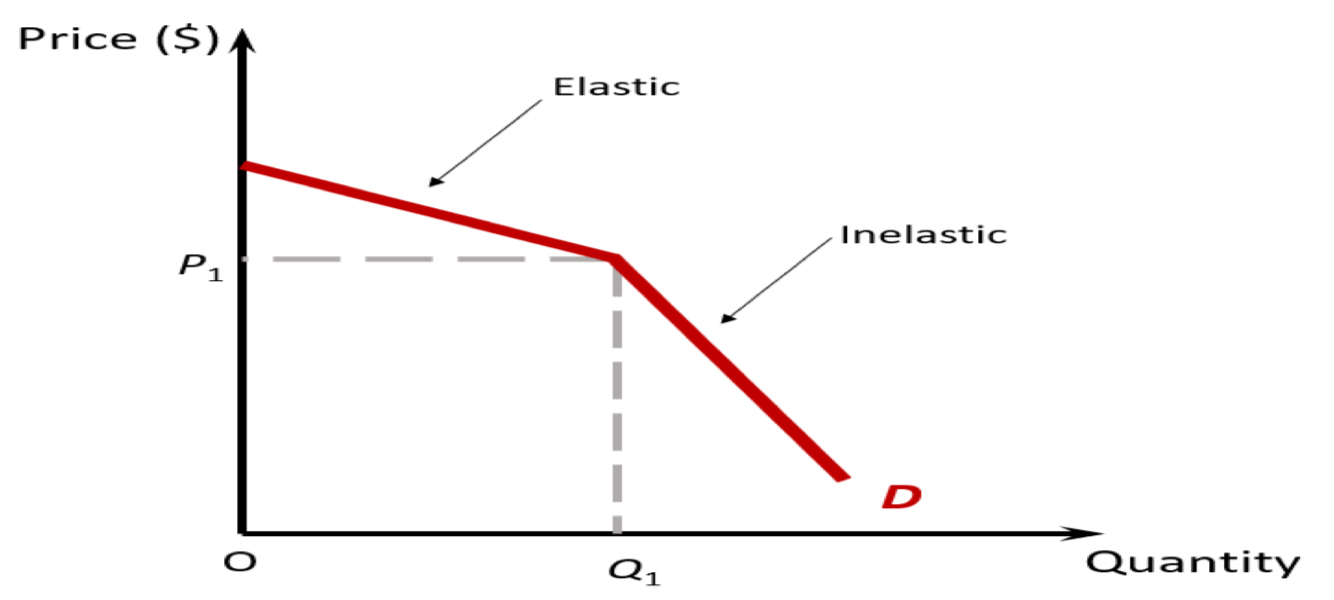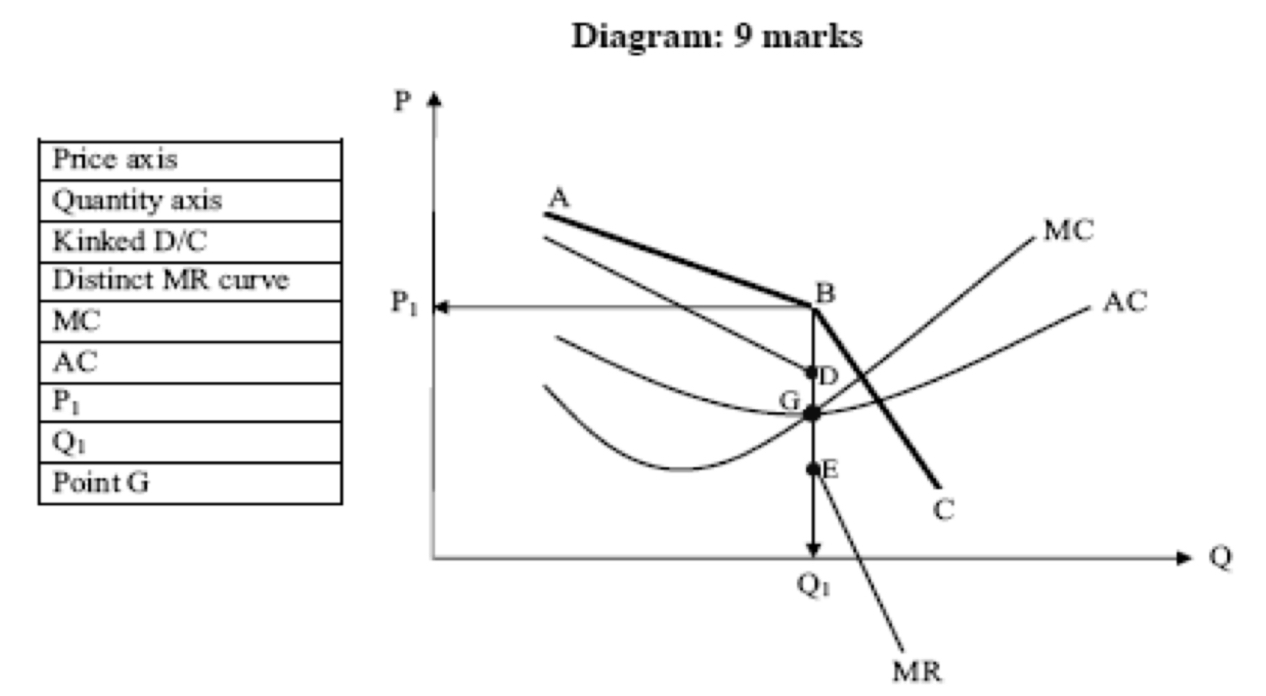Market Structures (3.1) - Oligopoly
1/20
There's no tags or description
Looks like no tags are added yet.
Name | Mastery | Learn | Test | Matching | Spaced |
|---|
No study sessions yet.
21 Terms
Oligopoly
A market structure in which a small number of firms producing the same good or close substitutes and who take account of each other’s reaction.
Key features of an Oligopoly
Interdependence between firms: Firms in oligopoly do not act independently of each other. They will each take into account the likely reactions of their competitors; hence prices tend to be rigid.
Product Differentiation: Firms will engage in advertising to persuade consumers that their product is better than a competitors product.
Barriers to entry: Barriers to entry continue to exist as existing firms will wish to maintain their share of the market. E.g. high start up costs.
Collusion may occur: Firms within an industry may meet to engage in anti competitive behavior for mutual benefit. Firms might attempt to control the output in the industry.
Non-price competition: Due to the fear of how competitors may react firms do not often use price competition.
Objectives of Oligopoly Firms
Prevent government market intervention/interference: Firms may fear that the existence of super-normal profits would attract government intervention into the market and therefore restrict the fir,s activities.
Discourage the entry of new firms into the industry: Firms may set prices at a low level which is intended to discourage the entry of new firms (limit pricing)
Maintain adequate profits: The owners of the business may prefer to earn stable/moderate levels of profits rather than constantly striving for large super-normal profits.
Price war
occurs when two or more rival companies’ lower prices of comparable products or services with the goal of stealing customers from their competitors.
Barriers to entry in an Oligopoly
High start up costs: some Oligopolistic firms operate at such a scale that the start up costs in the industry faced by potential entrants is so high that it would be unprofitable to set up a new firm.
Limit pricing: When new firms enter the industry, existing Oligopolistic firms may all agree to lower their price, meaning that the new entrant would be unable to match this price.
Brand Proliferation: Firms may gain monopoly power if, through their advertising, consumers are convinced that their is no suitable alternative to their particular brands.
Price competition
When firms compete with other prices on the basis of price.
Non-price competition
Occurs when firms try to increase their market share without changing their price (usually in order to avoid a price-war).
Reasons why consumers may prefer price competition/price wars
Lower Prices:
Higher disposable income:
More choice:
Reasons why consumers may prefer non-price competition
Consumer loyalty is rewarded:
Stability in prices: Prices will not be constantly changing and so consumers do not have to worry that they are losing on bargains, or they may be better able to budget.
Better quality commodities: Firms may improve the quality of their commodities; offer better services and/or provide after sales service to consumers.
Draw and explain the Oligopoly demand curve (kinked demand curve)
Demand - AB: If this firm increases its price, competitors will leave their prices unchanged so this form will lose many customers - this portion of the demand curve is elastic.
Demand - BC: If this form lowers its price, competitors will match this price decrease so this firm will gain a few additional customers - this portion of the demand curve is inelastic.

Explain the long run equilibrium position of an oligopoly firm.
Super Normal Profits: Average Revenue exceeds Average Cost(AR>AC), barriers to entry exist which result in the firms continuing to earn SNP’s
Price: The firms produces at Q1 and sells this output at price P1.
Equilibrium: Occurs at point G where Marginal Cost equals Marginal revenue (MC = MR) and Marginal Costs are rising (MC cuts MR from below)
Sticky Pricing: Should costs rise between points D & E then market price tends to remain constant at P1.

Price rigidity
In Oligopoly markets, price rigidity means that firms are reluctant to change their prices. this happens because one firm lowers prices, others will follow to avoid losing costumers, leading to lower profits.
Price Consistency
Price consistency means that firms in an oligopoly keep their prices stable over time even if costs of production change.
Collusion
Rival sellers in the industry come together for their mutual benefit.
Price Leadership
A situation in a market whereby a particular firm has the power to change prices, the result of which is that competitors follow this lead.
Implicit Collusion
happens when firms in an oligopoly indirectly cooperate without directly communicating. In this case, they behave as if they were a monopoly.
Explicit Collusion
When firms directly agree to cooperate, such as by fixing prices or dividing markets - known as a cartel.
Types of Collusion
Limit Pricing: One firm, with the tacit agreement of others, could reduce prices forcing unwanted entrants out of the industry.
Sales Territories: Firms agree to divide up the market between them (usually into geographic areas) and agree not to compete in each others market segments. This gives a firm monopolistic power in that area.
Implicit Collusion:
Advantages of Oligopolies
Stability in prices: Since firms are engaging in non-price competition, then prices tend to remain stable.
Profit Levels: Existence of high profits may mean that firms may be able to afford to engage in R&D(Innovate).
Benefits of advertising: Consumers may be better informed. This may save consumers time and money in searching for andlearning about goods and services.
Disadvantages of Oligopolies
Supernormal profits: SNP’s can be earned at the expense of the consumer. There may be a lack of innovation due to the existence of SNP.
Higher prices: If firms collude and decide to take a high price strategy, then this is not good for the consumer. Cartel like behaviour reduces competition and can lead to higher prices.
Restricted Choice: High concentration ratios reduce consumer choice of products/services.
Changes in market conditions which allow a monopoly to become an oligopoly.
Increased number of firms in the market: In a monopoly, there is only one firm whereas in an oligopoly there is a small number of large firms.
Product differentiation exists: Firms aim to increase their market share by engaging in non-price competition to avoid price wars. This is not applicable to a monopoly.
Removal of barriers to entry: There may be factors that exist (such as ownership of a patent) that prevents firms from entering the industry. When these are removed, firms can enter the industry leading to a shift to an oligopoly.